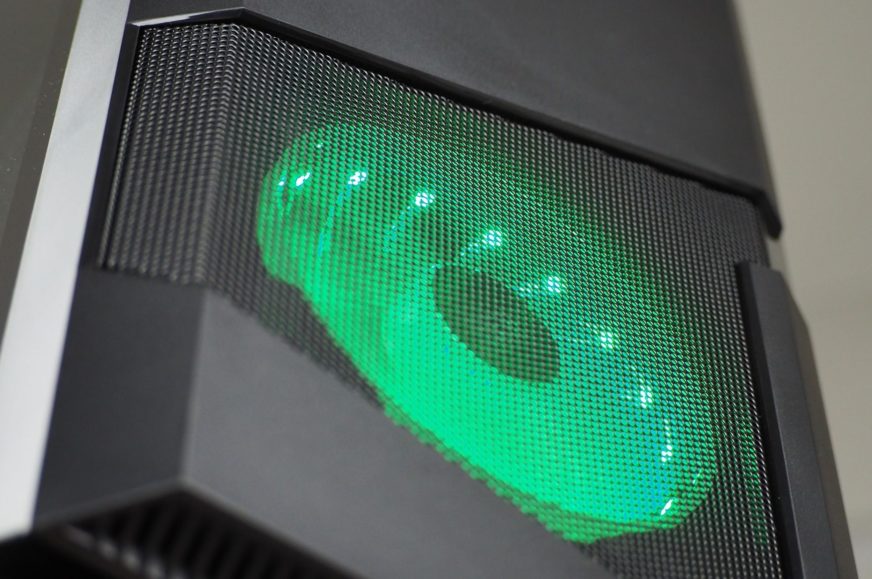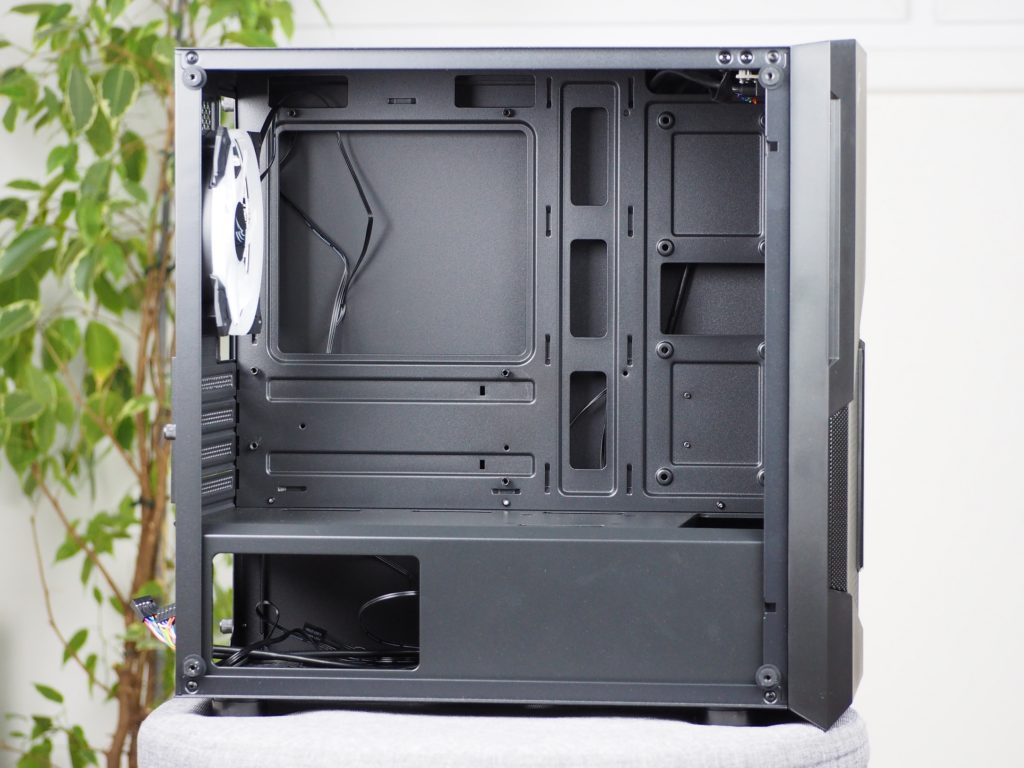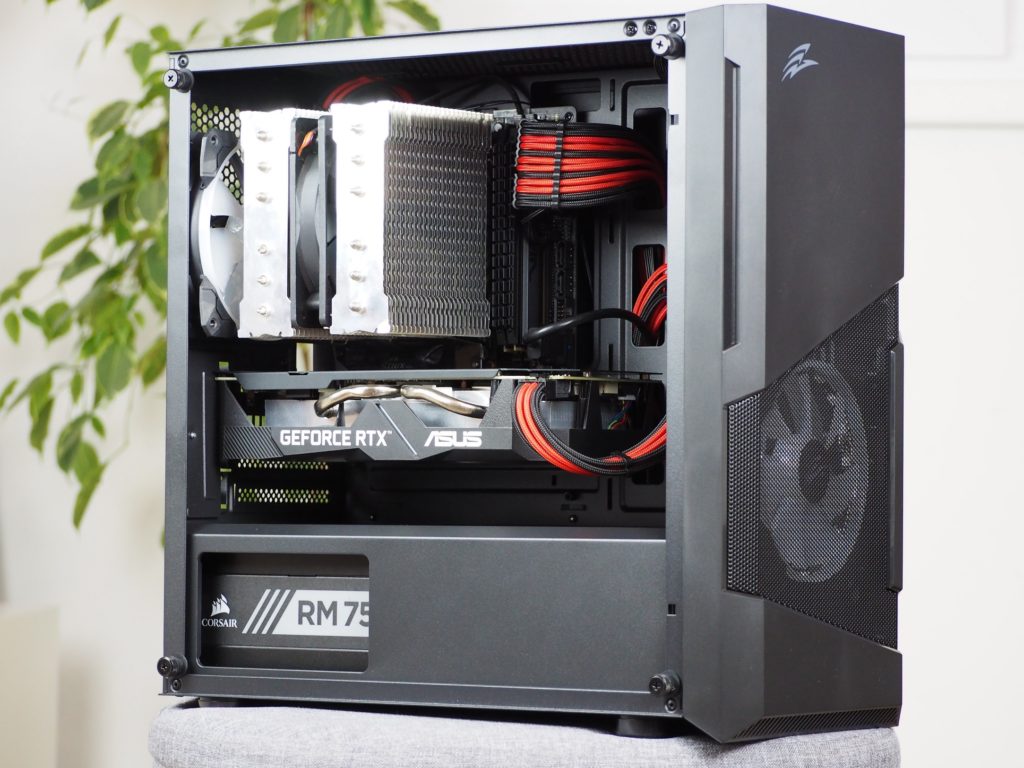Interior
Lower price usually goes hand in hand with lower quality materials or overall poorer build quality. This also applies to the tested Evolveo M5. With this case, you will come across a few places where the manufacturer has clearly skimped, but as long as you define yourself as a lower-end user, you’ll most likely be fine. The main advantage here may be the attractive price that probably won’t break the bank for you.
Interior
As the number of positions for PCI Express cards has already revealed, you can mount boards in ITX or M-ATX format inside, not larger ones. This is perhaps the only part where you are limited due to smaller dimensions. Of course, if you wanted to fit larger colossus tower CPU coolers like the NH-D15 or Dark Rock Pro 4, you’d run into the limits of the case. But you still have a free hand when choosing a cooler with a maximum size of up to 160 mm. For graphics cards, you also need to be careful not to exceed the 345mm limit. But this shouldn’t be difficult considering the case isn’t aimed for the most powerful and largest hardware of today.
Cost savings can be felt not only in dust filters but also in the absence of rubber caps for the cable grommets. But I’m not saying that this is a disadvantage. Sometimes when threading cables they are more of a detriment than a benefit when they don’t stay firmly in the holes. But the size of the grommets themselves is sufficient for all types of cables. On the tray they are 22 mm wide.
On the right there are two positions for two 2.5″ storage drives. These are placed less traditionally on this side of the case, not from the back of the tray.

The upper part of the tunnel is dotted with holes. Four are for cabling, even one by the side panel directly dedicated to additional power for the graphics card. This way, the cable doesn’t have to stretch across the entire inside of the case all the way to the card. Here the grommets are slightly narrower than the ones on the tray, their width is 17 mm. Between them there is one “bare” position for 2.5″ storage. More precisely, these are just its holes, through which you attach it. The storage itself is cleverly placed under the ceiling of the tunnel. The last of the holes near the front panel is 62mm wide and is for the potential placement of a liquid cooling radiator.
You may notice that the back of the tray doesn’t have a single Velcro pull-tab for cable management, which seems like a step in the wrong direction to me. Yes, we can argue that there are zip ties in the accessories. But then what about when the cables need to be re-organized again? Aside from that, the case offers 20mm of space in which to organize cables. Seven eyelet positions help you to do this, where you can definitely make use of those single-use zip ties.
To the left of the front panel, a power hub for up to four fans and also for the ARGB backlight is mounted on two screws. This entire unit is powered directly from the power supply via a SATA cable. However, it is very unfortunately designed, because when powering the fans it is not possible to control the speed of the fans through the motherboard. If you want to have them with regulation, you have to plug them directly into the connectors on the motherboard. But what you can regulate through it is the backlight. This, when plugged into the ARGB connector of the motherboard, can be synchronized and controlled using software directly from the motherboard manufacturer.
The metal tray and the right side panel are both 0,5 mm thick. These do bend as expected at this thickness, but they are not paper-like, so they should hold up.
The inside of the tunnel is partly customizable, thanks to a drawer for one 2.5″ and two 3.5″ storage drives. The drawer can be positioned (towards or away from the front panel) or even pulled out. With the drawer fitted, you get a maximum of 210 mm for the power supply and cables. Without it, the space increases to 340 mm. It’s creatively devised that even when the drawer is removed, you can still mount one 2.5″ storage on the ceiling of the tunnel. And in the end, it doesn’t interfere with anything either.
Cable management is not a strong point with this case. Without the use of single-use zip ties it was a misery. I used flexible wire to anchor the main branch of cables in the center, with which originally only the cables from the top I/O panel were held in place. The drive drawer was also slightly in the way, but I eventually managed to get it together and even closed the case with a side panel on the first try. The latter did bend a little to accommodate the cables, but you can’t see the bulge unless you focus on it. I would even say here that for longer cables, the flexibility of the side panel is a benefit.
- Contents
- Exterior
- Interior
- Test methodology
- CPU and GPU cooling tests
- Motherboard cooling tests
- SSD cooling tests
- Conclusion






















Hello, I just wanted to say how much I liked your pc cases reviews, noise normalized testing at few different levels, very important sheet metal thickness is something that no other reviewers or manufacturers tell and something that today can be disappointing even in pretty expensive cases. People need to know about actual mechanical properties of the cases as much as possible, because functionality is written in manuals and manufacturers websites, but they don’t tell you that your case panel will bend when you screw fan or radiator to it or that it falls apart when you try to take of something. Well that’s all I wanted to say, good luck. And start youtube, you can get big in it with good reviews.
Thank you for the compliments. We do not consider YouTube as a platform that is suitable for presenting our publications. We have a huge amount of data in most of our tests and it is based on the fact that everybody can choose what interests them (no need to wait for a lot of other things to pass that they don’t care about). Presenting it all in a video would be too boring for the typical viewer, and for the demanding user, who is primarily looking for hard data, it would be worse to navigate.
We like to write clearly structured xy-chapter articles, which contain, among other things, good details on testing methodologies. YT and videos in general are successful when the authors conceptualize it in the form of entertainment, often at the cost of embellishment or outright distortion of facts to create a desired wow effect. We will never do these things and instead focus on truly professional publications, and YT is not very good at that. See Aris’s PSU tests on Hardware Busters, which have pitifully few views. In short, not everything works in videos. In the same way, not everything works in text articles, the information value is much more important for their success.